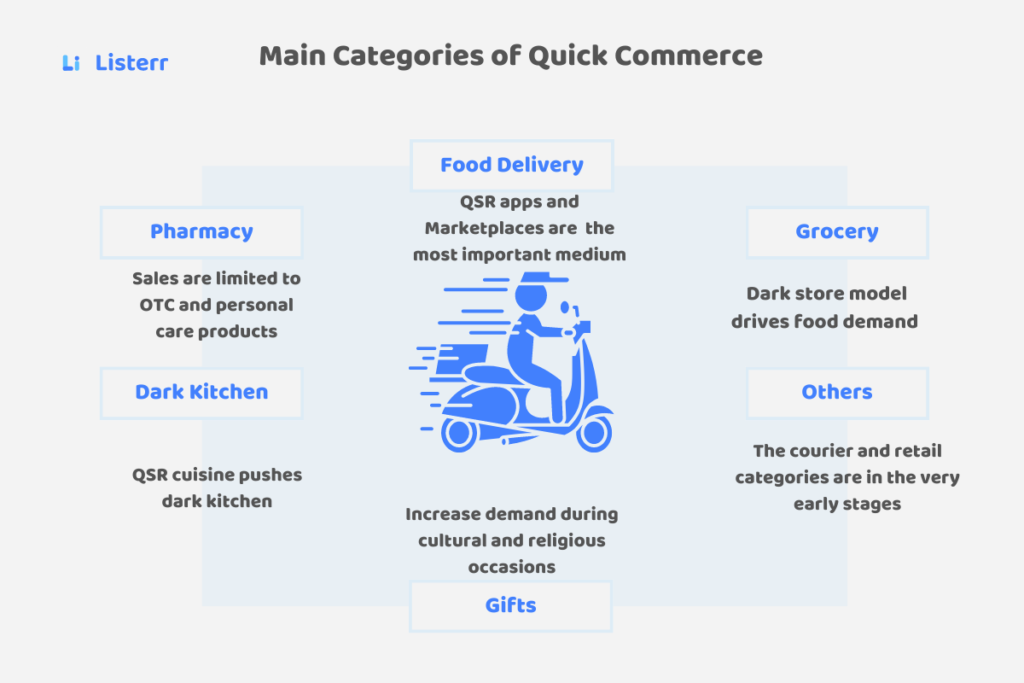
What is Quick Commerce?
Quick commerce is the next step in the evolution of e-commerce, and as the name implies, it’s all about speed. Rapid transactions generally mean that consumers can expect delivery within an hour of placing an order. This may look like a very short time frame, but quick deals are usually reserved for small orders rather than weekly groceries. Consumers may have unexpectedly run out of products or purchased the ingredients they need for tonight’s supper. To ship orders as quickly as possible, retailers rely on online ordering systems, local warehouses, and motorcycle delivery teams. Fast trading is not new when you think about it. It has been used for many years in the takeaway food industry. E-commerce brands are constantly reducing delivery times, so it was only a
matter of time before consumers were able to deliver other products to the front door without delay.
How Quick Commerce is changing India’s e-commerce environment?
The days of buying groceries weekly or monthly at your nearest grocery store are over. In an era of instant satisfaction, groceries and snacks are delivered at the touch of a button in one app. Hello Quick Trading! The quick commerce platform has evolved into a subset of e-commerce, becoming the savior of the always-busy millennial generation with many offices. Quick commerce is rapidly gaining in popularity, and it all started when the e-commerce industry began to expand its reach to accommodate segments such as groceries, frozen foods, fresh fruits and vegetables. This expansion is due to changes in consumer behavior due to pandemics, and people are paying attention to spending less on clothing and other lifestyle items and buying groceries online. Because most of the products in the grocery segment are perishable, companies have begun to adopt a 10-20 minute grocery delivery model known as quick commerce or Q commerce.
Several new quick commerce companies have grown rapidly in the Indian market. Few food aggregators or taxi services provide Q-commerce services to their customers. Statistically, the market size of India’s rapid trade in 2020 was about US $ 49 billion. According to a study conducted by strategic consultancy Redseer, high-speed transactions will grow 10 to 15 times by 2025, reaching a market size of nearly $ 5.5 billion, and other markets (including China) in terms of adopting high-speed transactions.

Advantages of Quick Commerce
There are many advantages of Quick Commerce. Some of the advantages are :
Competitive and unique products for sale
Q-Commerce provides companies with new value propositions that truly differentiate them from their competitors. Customers who need immediate delivery may be willing to try new products or order from new stores. The additional convenience of fast trading allows online retailers to compete with large multinational markets and physical stores like Amazon.
Margin can be large
Fast trading brings a lot of potential profits to those who make a profit.During the pandemic, 50% of shoppers spent extra money getting what they needed easily. They paid an extra fee for on-demand fulfillment and purchased an online pickup in-store option. Because Q-commerce has few product choices, retailers can also take this opportunity to increase sales of their most profitable products. It is also worth noting that convenience often appeals to wealthier demographics. For example, a time-hungry professional or business leader who values convenience over discounts.
Providing the optimum customer experience
As consumer expectations grow, quick commerce can help online merchants meet and exceed them. This increases brand loyalty. Customers often point out that quick commerce addresses make sense. It can save the party organizers who have run out of food. It can help his uncle who forgot to buy a birthday present for his niece. Or you can help people who can’t go to the store stock up on their essentials. There are many situations where the convenience of q-commerce can reduce stress and possibly avoid disasters.
Ultra-quick delivery
Consumers can expect the order to be delivered within the shortest possible time within 10 minutes, 30 minutes, or 60 minutes immediately after ordering. Retailers can take advantage of all-in-one rapid B2B commerce solutions to streamline warehousing operations, prepare and ship orders as quickly as possible, improve efficiency and complete orders in the shortest amount of time.
Small format dark stores and warehouses
This is one of the key elements of the quick commerce model. To process orders in minutes, retailers need to set up micro fulfillment centers or dark stores in densely populated areas near delivery points to speed up the hyperlocal order processing process. Large retailers can add multiple smaller storage facilities to meet their urgent or unplanned needs.

A fast future for e-commerce
The Covid-19 pandemic has completely disrupted consumer shopping behavior. Some consumers are now shopping in-store, while others prefer to shop online for convenience. The use of quick commerce is certainly accelerating, but it was already increasing before the pandemic. Well, those newly formed habits go nowhere. Digital natives continue to demand immediate satisfaction from their online shopping experience. Market experts already anticipate rapid growth in e-commerce, and the development of new technologies such as drones, electric vehicles, voice orders, and dark store automation will accelerate this segment in the future.
Dark StoresE-CommerceQuick Commerce

